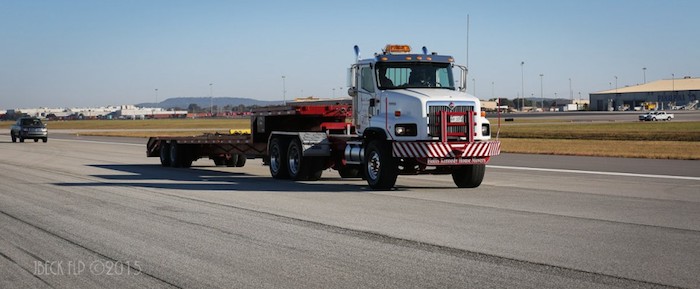.

Morell Engineering installing & testing thermocouple data collector & sensors. (Juergen Beck/Freedom Light Productions)
.
Huntsville is a step closer to landing a spaceship at its international airport. Now, if it can just get a federal blessing for the sonic boom that will be heard in three states when the ship approaches.
Officials said today they were "successful" in the first phase of testing whether Sierra Nevada Corp's Dream Chaser could safely and without damage land at the Huntsville International Airport. The Colorado company is developing the mini-space shuttle to ferry cargo and eventually astronauts to and from low-Earth orbit. It will take off atop a United Launch Alliance Atlas 5 rocket built in nearby Decatur, Ala.
"No airport related issues were discovered in this phase of testing that would prevent the Dream Chaser landing in Huntsville from becoming a reality," Rick Tucker, executive director for Huntsville-Madison County Airport Authority, said in a statement.
A concern for airport officials was the impact of Dream Chaser's front skid pad on its embedded-light runways. The spaceship uses a skid plate instead of a front wheel for landing.
Results of a skid test "demonstrate that runway impacts would be negligible," according to test engineers.
Other findings of the study include:
- "Significant coordination of airspace" will be needed between the Federal Aviation Administration and regional aircraft control centers in Memphis and Atlanta. But those centers believe it is "feasible," and the study says, "There are no 'show stoppers.'"
- The sonic boom from Dream Chaser's approach will be heard over 13,000 square miles and three states. That may mean a federal Environmental Assessment to study the impact on parks, recreational sites and historical properties.
"We are very excited about the results from the initial phase of the study," Huntsville Mayor Tommy Battle said Thursday. "Our historic leadership in space combined with our great partnership with Sierra Nevada Corporation make Huntsville a logical choice to land the Dream Chaser, and we look forward to conducting additional studies."
"Landing the Dream Chaser at Huntsville International Airport would be an exciting next step for the Rocket City," said Lucia Cape, senior vice president of economic development for the Chamber of Commerce of Huntsville/Madison County. "In addition to having the required infrastructure for landing the vehicle, we have the expertise and assets for payload integration, operation and processing for Dream Chaser customers and we have great collaboration among our airport authority, elected officials and local businesses."
.
HUNTSVILLE INTERNATIONAL AIRPORT LANDING SITE STUDY PHASE 1 RESULTS OVERVIEW
In conjunction with the Huntsville International Airport and a coalition of community leadership, Teledyne Brown Engineering, Morrell Engineering, and Reynolds Smith & Hills Engineering (RS&H) have completed the first phase of a study to determine the feasibility and compatibility of landing future space vehicles - specifically the Sierra Nevada
Dream Chaser
® - at the Huntsville International Airport Results of the initial study include:
Significant coordination of airspace use between the Federal Aviation Administration (FAA) and the Air Traffic Control Centers (ARTCCs) in Memphis and Atlanta will be necessary, but Memphis and Atlanta believe that Dream Chaser integration in
to the airspace is feasible. There are no “show stoppers.” Additional flight details are required to perform a
better analysis.
Both runways are long and wide enough to support Dream Chaser. However, due to the touch down and centerline lighting on the west runway, the east runway (Runway 18L-36R) will be proposed as the primary runway for Dream Chaser.
The quantities and types of chemicals and propellants that will exist on the Dream Chaser vehicle on landing were provided by SNC. The east runway has enough separation between the vehicle and inhabited buildings and public traffic routes to support the Dream Chaser and slightly larger quantities of propellants.
The sonic boom will be heard over 13,000 square miles and 3 states. An Environmental Assessment is expected to be the most appropriate NEPA documentation required for the proposed operations. The assessment will determine potential constructive use impacts to parks and recreation sites, and historic properties that are protected under Department of Transportation Section 4(f) and Section 106 of the National Historic Preservation Act.
Based on observations made during both the static and dynamic tests, minimal damage to the asphalt surface is expected under the following conditions:
–
The skid is allowed to completely cool to a temperature less than 250°F
–
The skid should initially be pulled across the asphalt surface prior to attempting to lift the skid from the surface. This will help prevent fine aggregate and asphalt cement from adhering to t
he skid’s surface
–
The area of asphalt that may be adversely affected by the skid should be less than two (2) square feet The project team is currently securing funding to proceed with Phase 2 of the study which will include securing the appropriate licenses and further environmental impact testing and logistics analysis.
.

Skid cooling on runway after final dynamic test(Juergen Beck/Freedom Light Productions)
.

Skid tow vehicle during trial run for dynamic testing (Juergen Beck/Freedom Light Productions)
.

Sierra Nevada Corp.'s Dream Chaser with the Space Shuttle Atlantis in this June 2014 picture (Contributed by Sierra Nevada Corp.)
Quelle: AL
4739 Views
